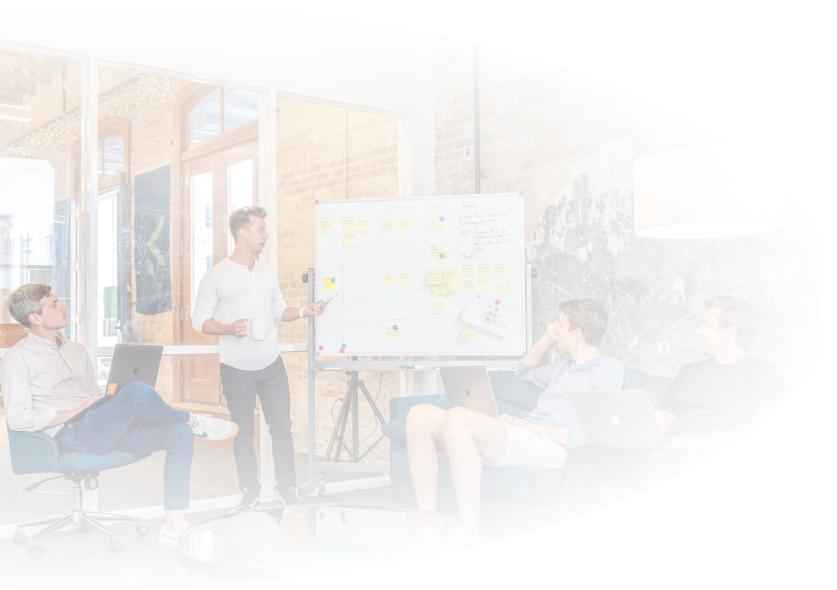DaaS
There are 150 million start-ups in the world today with 50 million new start-ups launching every year. On average, there are 137,000 businesses launched every day in the world. It’s easy to come up with ideas. We all have a few of them. The idea we choose to pursue because of passion isn’t always the right idea. Most ideas changes in response to customer feedback. Most entrepreneurs sometimes would rather quit than iterate or pivot their original plan to address customer needs.




Development as a Service
Complex product software development comes with its own set of everyday challenges like UI/UX design, Adapt to Market Trends, ROI, Project Management, etc. Challenges that need to be addressed to reduce the impact they have on your end product.



The Problem
Survival of the fittest’ theory fit really well with the world of start-ups. And the world of start-ups is a vicious one.
Game changing ideas/Innovations are never urgent in nature: they are something to be implemented in the long run. No matter how big or small, solving software development challenges never comes easy. From challenges in requirements to integrating new technologies, from ensuring end-to-end security to challenges of duplicating efforts Software product development requires you to be clear and focused on the problem you’ve set out to solve in order to achieve what you’ve set out to achieve. But the question remains, how many start-ups tend to survive the brutal waves of change that have completely transformed the very nature of today’s start-ups?
Game changing ideas/Innovations are never urgent in nature: they are something to be implemented in the long run. No matter how big or small, solving software development challenges never comes easy. From challenges in requirements to integrating new technologies, from ensuring end-to-end security to challenges of duplicating efforts Software product development requires you to be clear and focused on the problem you’ve set out to solve in order to achieve what you’ve set out to achieve. But the question remains, how many start-ups tend to survive the brutal waves of change that have completely transformed the very nature of today’s start-ups?




How We Solve them
Stay clear and Focused

Browse through Snipeet Talent Services
From idea conceptualization, web design, mobile app development, persona analysis, virtual assistants, graphic design, go to market strategy and more. lets start small, we have provided you with a list of popular services our talents can do, choose the one that interests you
There never seems to be enough funding for our ideas. Idea after idea come to us on a daily or weekly basis; some of which we act on, and still others we put on the back burner of the mind for a time when we have more money.
Bootstrapping is about using your savings or income to fund a business. but there are other options for start-ups like Development as a Service (Daas), a Snipeet subscription model.
The rise of outsourced work has disrupted entrepreneurship. Research shows that outsourced workers are more productive. Snipeet development as a service subscription model allows you to build your software product with its vast talent pool at your own pace and budget with a few clicks.
Bootstrapping is about using your savings or income to fund a business. but there are other options for start-ups like Development as a Service (Daas), a Snipeet subscription model.
The rise of outsourced work has disrupted entrepreneurship. Research shows that outsourced workers are more productive. Snipeet development as a service subscription model allows you to build your software product with its vast talent pool at your own pace and budget with a few clicks.



(Daas) Snipeet subscription model
So affordable. So simple. So easy to use.
Bringing all your idea to life has never been this simple.
Weekly Minimum Spend
20 hours per week is the minimum required time for Talent to successfully produce result. Each phase requires different talents to be involved it depends on the project that is built. Our rate starts from $40- $550 per hour per talent involved in your project.
We built our services on flexibility, just write us, and we will find ways to co-operate with you.
We built our services on flexibility, just write us, and we will find ways to co-operate with you.
Marketing is at the heart of your product. You can have the best product in the world, but it won't be successful if nobody knows about it. Snipeet has Sales and Marketing services to support clients is an essential part of us.








Each phase comes with consultations and meetings. The more you are informed the more you understand your product.

Our Talents can guide you through whatever task you have. Be its marketing strategy for your application or architecture designs or hardware schemes. Inform us and together we will find the way.

Phase 1
Requirement collection
Phase 2
Design
Phase 3
Software development
Phase 4
Testing
Phase 5
Deployment
Phase 6
Maintenance
Software Development Life Cycle
Phase 1. Requirement collection

Possible Talents that can be allocated on this stage
Project/Product managers
Business analysts
Designers
The goal of the phase is to gather and document business requirements.
This step includes requirements collection of software product development from stakeholders, industry experts, and even potential customers. After that, the project owners outline the project scope, defining a budget, resources, deadlines, and potential risks and quality assurance requirements.
All requirements are gathered in a formal document, Software Requirement Specification. Project managers, business analysts, and software developers will refer to this document frequently.
Project/Product managers
Business analysts
Designers
The goal of the phase is to gather and document business requirements.
This step includes requirements collection of software product development from stakeholders, industry experts, and even potential customers. After that, the project owners outline the project scope, defining a budget, resources, deadlines, and potential risks and quality assurance requirements.
All requirements are gathered in a formal document, Software Requirement Specification. Project managers, business analysts, and software developers will refer to this document frequently.
Phase 2. Design

Possible Talents that can be allocated on this stage
Project/Product managers
Designers
Backend-architecture developers
The goal of the phase is to translate software development requirements into design.
This stage involves designing the entire system and its elements.
It includes high-level design and low-level design:
High-level design (HLD) is a system's architectural design:
● System elements and how they interact with each other. The information is presented in the form of cases (as in "by performing step A, you get the result B");
● Implementation. This section includes a table containing concise information about the main stages of software product development;
● HLD should contain information about resources, technologies, and information on possible risks (and how to prevent them), as well as ways to recover the system in case of failure.
Low-level design (LLD) is a detailed description of all components, configurations, and processes of IT infrastructure:
● Layout and connection of equipment;
● Software module installation schemes;
● Specifications of the operating modes of the system's components.
Project/Product managers
Designers
Backend-architecture developers
The goal of the phase is to translate software development requirements into design.
This stage involves designing the entire system and its elements.
It includes high-level design and low-level design:
High-level design (HLD) is a system's architectural design:
● System elements and how they interact with each other. The information is presented in the form of cases (as in "by performing step A, you get the result B");
● Implementation. This section includes a table containing concise information about the main stages of software product development;
● HLD should contain information about resources, technologies, and information on possible risks (and how to prevent them), as well as ways to recover the system in case of failure.
Low-level design (LLD) is a detailed description of all components, configurations, and processes of IT infrastructure:
● Layout and connection of equipment;
● Software module installation schemes;
● Specifications of the operating modes of the system's components.
Phase 3. Software development

Possible Talents that can be allocated on this stage
Project/Product managers
Designers
Backend-architecture developers
Front-end developers
Mobile developers
Manual testers
Automation testers
Project
The goal of the phase is to build the actual software.
Software development is the most time-consuming phase. Unlike the Design phase, it's more predictable. Using the design document, software developers write code for the components. The tasks are assigned between the team members according to their area of specialization.
Back-end developers are responsible for server-side development that incorporates all the processes that go behind the scene. The management of databases, servers, and logical components are the main components of the back-end.
The back-end is not tangible for the users, but without a strong back-end development team, your product will be an empty page that can not do any tasks.
Front-end software developers are responsible for creating an interface and its communication with the server.
Software developers use coding guidelines and various tools to write and implement code. The result of this phase is a working software product and a Source Code Document.
Project/Product managers
Designers
Backend-architecture developers
Front-end developers
Mobile developers
Manual testers
Automation testers
Project
The goal of the phase is to build the actual software.
Software development is the most time-consuming phase. Unlike the Design phase, it's more predictable. Using the design document, software developers write code for the components. The tasks are assigned between the team members according to their area of specialization.
Back-end developers are responsible for server-side development that incorporates all the processes that go behind the scene. The management of databases, servers, and logical components are the main components of the back-end.
The back-end is not tangible for the users, but without a strong back-end development team, your product will be an empty page that can not do any tasks.
Front-end software developers are responsible for creating an interface and its communication with the server.
Software developers use coding guidelines and various tools to write and implement code. The result of this phase is a working software product and a Source Code Document.
Phase 4.Testing

Possible Talents that can be allocated on this stage
Manual testers
Automation testers
Designers
Mobile/Front/Back-end developers
The goal of the phase is to ensure the software meets requirements.
After a development team completes programming software, it's time for the Quality Assurance (QA) team to step in. The QA team tests the software to measure its quality. During this phase, the software undergoes different kinds of tests:
● Functional testing: Ensuring that software is in line with the requirements described in the Software Requirement Specification.
● Performance testing aimed to determine how the software works under a workload (speed, responsiveness, and stability).
● Unit testing: Testing each component individually. If any of those has a flaw, software developers responsible for it have to go back and fix it.
● Security testing: As the name suggests, this type of testing aims to verify the system's security.
● Usability testing: This type of test involves testing user-facing components to determine if the software is intuitive, easy to use, and understandable for users.
At this stage, bugs are fixed by Software developers. After that, the QA team tests the software or its components again. Quality assurance is an ongoing process that continues until the software is entirely free of bugs and meets the requirements.
Manual testers
Automation testers
Designers
Mobile/Front/Back-end developers
The goal of the phase is to ensure the software meets requirements.
After a development team completes programming software, it's time for the Quality Assurance (QA) team to step in. The QA team tests the software to measure its quality. During this phase, the software undergoes different kinds of tests:
● Functional testing: Ensuring that software is in line with the requirements described in the Software Requirement Specification.
● Performance testing aimed to determine how the software works under a workload (speed, responsiveness, and stability).
● Unit testing: Testing each component individually. If any of those has a flaw, software developers responsible for it have to go back and fix it.
● Security testing: As the name suggests, this type of testing aims to verify the system's security.
● Usability testing: This type of test involves testing user-facing components to determine if the software is intuitive, easy to use, and understandable for users.
At this stage, bugs are fixed by Software developers. After that, the QA team tests the software or its components again. Quality assurance is an ongoing process that continues until the software is entirely free of bugs and meets the requirements.
Phase 5. Deployment

Possible Talents that can be allocated on this stage
Project/Product managers
Designers
Mobile/Front/Back-end developers
The goal of the phase is to deliver completed software to users.
It might be possible to deploy straightforward projects in a single release to customers.
For more complex products, developers will stagger the release into stages:
Beta testiтg - rolling out software to a limited number of users, and treating their experience of using it as part of the product testing.
A staggered process also means that additional functions can be added over time, and released only when they are ready.
Project/Product managers
Designers
Mobile/Front/Back-end developers
The goal of the phase is to deliver completed software to users.
It might be possible to deploy straightforward projects in a single release to customers.
For more complex products, developers will stagger the release into stages:
Beta testiтg - rolling out software to a limited number of users, and treating their experience of using it as part of the product testing.
A staggered process also means that additional functions can be added over time, and released only when they are ready.
Phase 6. Maintenance

Possible Talents that can be allocated on this stage
Project/Product managers
Designers
Mobile/Front/Back-end developers
The goal of the phase is to keep the product working and its constant strengthening.
Developers treat the maintenance phase seriously. In response to how the product performs in the real world, it is the time when a product is improved.
The developers' reputations depend on their ability to create solid software that functions as it should. It comes from maintaining a product, perhaps for months or even years after deployment.
Project/Product managers
Designers
Mobile/Front/Back-end developers
The goal of the phase is to keep the product working and its constant strengthening.
Developers treat the maintenance phase seriously. In response to how the product performs in the real world, it is the time when a product is improved.
The developers' reputations depend on their ability to create solid software that functions as it should. It comes from maintaining a product, perhaps for months or even years after deployment.
Our Talents can guide you through whatever task you have. Be its marketing strategy for your application or architecture designs or hardware schemes. Inform us and together we will find the way.
How it works
An opportunity to build at your own pace and budget regardless of what stage of development your project is. We can help make a difference.
Step 1
Step 2
Step 3
Amount of investments
Decide how much you are willing to spend, make sure it aligns with Snippet minimum weekly spend.
1

Talent consultation
A Snipeet talent will work with you to Choose what section of your project to work on. I.e., idea conceptualization, design, website development, product development, marketing, or sales systems, go to market strategy or customer persona.
We guide you through the process to make sure there is incremental progress to avoid time and money wastage.
We guide you through the process to make sure there is incremental progress to avoid time and money wastage.
2

Flexible workflow
When you run out of funds, put your project on hold. Come back at any time to continue.
Place a request to continue from your personal page.
One of our Snipeet talent we reach out to you to recap where the project left off, understand the next milestone, learn about your financial commitments to recommend, and structure the next milestone.
Place a request to continue from your personal page.
One of our Snipeet talent we reach out to you to recap where the project left off, understand the next milestone, learn about your financial commitments to recommend, and structure the next milestone.
3

Use your day job to fund your side project
Request a talent to learn about how we can help you
Our Process recaps
We believe that an idea is more than just creating mobile applications or websites that look good. We translate your idea into a scalable technology solution following a proven process.
1
We always start with a free consultation, where you’ll speak with our Business Analyst/Project Manager and other team members to discuss your idea in detail. We will provide advice, approximate pricing, and recommendations for the future.
Free Consultation


UX/UI Design
Snipeet is all about design thinking. Our UX/UI designers will guide you through all stages of the design process to get your concept to meet all technical and consumer aspects.
3

Testing & Quality Assurance
Snipeet Test team will carry out testing of whole your product to be sure that everything is delivered as it should.
5

Support
After delivery of your product, we will build a personalized support services package based on your needs.
7

Conceptualization
Snipeet will run one or more discovery sessions to hear your idea vision. Based on Snipeet expertise and research, Snipeet will guide you to conceptualize your idea and architect a plan to execute it.
2

Development
You’ll be able to watch the progress and offer real-time feedback to ensure the end product matches your expectations. Snipeet development team will turn your idea into a digital product that you want.
4

Launch & Deployment
We will launch your product after we test it to make sure your application works perfectly on various devices.
6
Let's catch up for a virtual coffee

+6 141 680 79 96
support@snipeet.com
320 Pitt Street Sydney, NSW 2000















